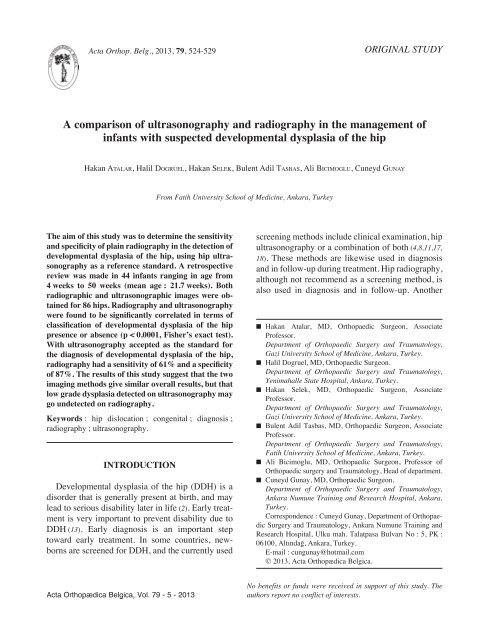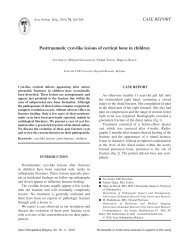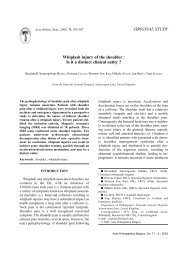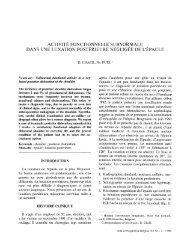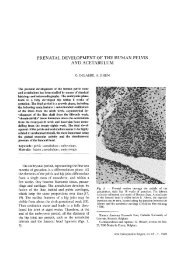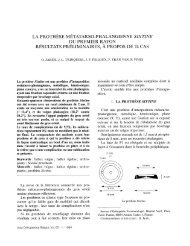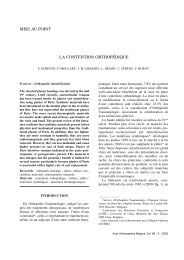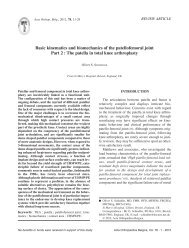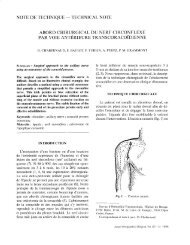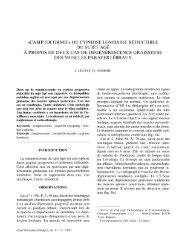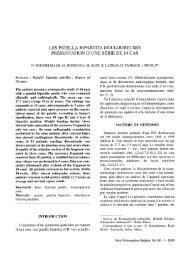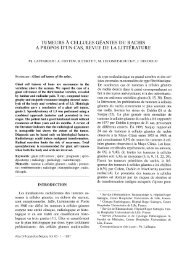A comparison of ultrasonography and radiography in the ...
A comparison of ultrasonography and radiography in the ...
A comparison of ultrasonography and radiography in the ...
You also want an ePaper? Increase the reach of your titles
YUMPU automatically turns print PDFs into web optimized ePapers that Google loves.
Acta Orthop. Belg., 2013, 79, 524-529<br />
ORIGINAL STUDY<br />
A <strong>comparison</strong> <strong>of</strong> <strong>ultrasonography</strong> <strong>and</strong> <strong>radiography</strong> <strong>in</strong> <strong>the</strong> management <strong>of</strong><br />
<strong>in</strong>fants with suspected developmental dysplasia <strong>of</strong> <strong>the</strong> hip<br />
Hakan Atalar, Halil Dogruel, Hakan Selek, Bulent Adil Tasbas, Ali Bicimoglu, Cuneyd Gunay<br />
From Fatih University School <strong>of</strong> Medic<strong>in</strong>e, Ankara, Turkey<br />
The aim <strong>of</strong> this study was to determ<strong>in</strong>e <strong>the</strong> sensitivity<br />
<strong>and</strong> specificity <strong>of</strong> pla<strong>in</strong> <strong>radiography</strong> <strong>in</strong> <strong>the</strong> detection <strong>of</strong><br />
developmental dysplasia <strong>of</strong> <strong>the</strong> hip, us<strong>in</strong>g hip <strong>ultrasonography</strong><br />
as a reference st<strong>and</strong>ard. A retrospective<br />
review was made <strong>in</strong> 44 <strong>in</strong>fants rang<strong>in</strong>g <strong>in</strong> age from<br />
4 weeks to 50 weeks (mean age : 21.7 weeks). Both<br />
radiographic <strong>and</strong> ultrasonographic images were obta<strong>in</strong>ed<br />
for 86 hips. Radiography <strong>and</strong> <strong>ultrasonography</strong><br />
were found to be significantly correlated <strong>in</strong> terms <strong>of</strong><br />
classification <strong>of</strong> developmental dysplasia <strong>of</strong> <strong>the</strong> hip<br />
presence or absence (p < 0.0001, Fisher’s exact test).<br />
With <strong>ultrasonography</strong> accepted as <strong>the</strong> st<strong>and</strong>ard for<br />
<strong>the</strong> diagnosis <strong>of</strong> developmental dysplasia <strong>of</strong> <strong>the</strong> hip,<br />
<strong>radiography</strong> had a sensitivity <strong>of</strong> 61% <strong>and</strong> a specificity<br />
<strong>of</strong> 87%. The results <strong>of</strong> this study suggest that <strong>the</strong> two<br />
imag<strong>in</strong>g methods give similar overall results, but that<br />
low grade dysplasia detected on <strong>ultrasonography</strong> may<br />
go undetected on <strong>radiography</strong>.<br />
Keywords : hip dislocation ; congenital ; diagnosis ;<br />
<strong>radiography</strong> ; <strong>ultrasonography</strong>.<br />
INTRODUCTION<br />
Developmental dysplasia <strong>of</strong> <strong>the</strong> hip (DDH) is a<br />
disorder that is generally present at birth, <strong>and</strong> may<br />
lead to serious disability later <strong>in</strong> life (2). Early treatment<br />
is very important to prevent disability due to<br />
DDH (13). Early diagnosis is an important step<br />
toward early treatment. In some countries, newborns<br />
are screened for DDH, <strong>and</strong> <strong>the</strong> currently used<br />
screen<strong>in</strong>g methods <strong>in</strong>clude cl<strong>in</strong>ical exam<strong>in</strong>ation, hip<br />
<strong>ultrasonography</strong> or a comb<strong>in</strong>ation <strong>of</strong> both (4,8,11,17,<br />
18). These methods are likewise used <strong>in</strong> diagnosis<br />
<strong>and</strong> <strong>in</strong> follow-up dur<strong>in</strong>g treatment. Hip <strong>radiography</strong>,<br />
although not recommend as a screen<strong>in</strong>g method, is<br />
also used <strong>in</strong> diagnosis <strong>and</strong> <strong>in</strong> follow-up. Ano<strong>the</strong>r<br />
n Hakan Atalar, MD, Orthopaedic Surgeon, Associate<br />
Pr<strong>of</strong>essor.<br />
Department <strong>of</strong> Orthopaedic Surgery <strong>and</strong> Traumatology,<br />
Gazi University School <strong>of</strong> Medic<strong>in</strong>e, Ankara, Turkey.<br />
n Halil Dogruel, MD, Orthopaedic Surgeon.<br />
Department <strong>of</strong> Orthopaedic Surgery <strong>and</strong> Traumatology,<br />
Yenimahalle State Hospital, Ankara, Turkey.<br />
n Hakan Selek, MD, Orthopaedic Surgeon, Associate<br />
Pr<strong>of</strong>essor.<br />
Department <strong>of</strong> Orthopaedic Surgery <strong>and</strong> Traumatology,<br />
Gazi University School <strong>of</strong> Medic<strong>in</strong>e, Ankara, Turkey.<br />
n Bulent Adil Tasbas, MD, Orthopaedic Surgeon, Associate<br />
Pr<strong>of</strong>essor.<br />
Department <strong>of</strong> Orthopaedic Surgery <strong>and</strong> Traumatology,<br />
Fatih University School <strong>of</strong> Medic<strong>in</strong>e, Ankara, Turkey.<br />
n Ali Bicimoglu, MD, Orthopaedic Surgeon, Pr<strong>of</strong>essor <strong>of</strong><br />
Orthopaedic surgery <strong>and</strong> Traumatology, Head <strong>of</strong> department.<br />
n Cuneyd Gunay, MD, Orthopaedic Surgeon.<br />
Department <strong>of</strong> Orthopaedic Surgery <strong>and</strong> Traumatology,<br />
Ankara Numune Tra<strong>in</strong><strong>in</strong>g <strong>and</strong> Research Hospital, Ankara,<br />
Turkey.<br />
Correspondence : Cuneyd Gunay, Department <strong>of</strong> Orthopaedic<br />
Surgery <strong>and</strong> Traumatology, Ankara Numune Tra<strong>in</strong><strong>in</strong>g <strong>and</strong><br />
Research Hospital, Ulku mah. Talatpasa Bulvarı No : 5, PK :<br />
06100, Altındağ, Ankara, Turkey.<br />
E-mail : cungunay@hotmail.com<br />
© 2013, Acta Orthopædica Belgica.<br />
Acta Orthopædica Belgica, Vol. 79 - 5 - 2013<br />
No benefits or funds were received <strong>in</strong> support <strong>of</strong> this study. The<br />
authors report no conflict <strong>of</strong> <strong>in</strong>terests.
suspected developmental dysplasia <strong>of</strong> <strong>the</strong> hip 525<br />
imag<strong>in</strong>g method is magnetic resonance imag<strong>in</strong>g,<br />
which shows <strong>the</strong> develop<strong>in</strong>g anatomy <strong>of</strong> <strong>the</strong> hip<br />
clearly but is used only <strong>in</strong> selected patients because<br />
it requires sedation.<br />
Advantages <strong>of</strong> <strong>ultrasonography</strong> are that it is non<strong>in</strong>vasive,<br />
does not <strong>in</strong>volve radiation, <strong>and</strong> can show<br />
<strong>the</strong> cartilag<strong>in</strong>ous structures <strong>of</strong> <strong>the</strong> hip jo<strong>in</strong>t. Hip <strong>ultrasonography</strong><br />
by <strong>the</strong> Graf method uses alpha <strong>and</strong><br />
beta angles which are measured via coronal imag<strong>in</strong>g<br />
<strong>of</strong> <strong>the</strong> hip jo<strong>in</strong>t. The Graf method for diagnos<strong>in</strong>g<br />
DDH is widely used because it is easy to apply <strong>and</strong><br />
has been found to have low <strong>in</strong>tra- <strong>and</strong> <strong>in</strong>terobserver<br />
variability (9).<br />
Radiography is likewise an easy method, but <strong>in</strong><br />
young <strong>in</strong>fants it does not show <strong>the</strong> cartilag<strong>in</strong>ous hip<br />
structures as well as <strong>ultrasonography</strong> does. For <strong>the</strong><br />
evaluation <strong>of</strong> suspected DDH, <strong>the</strong> most useful radiographic<br />
features <strong>in</strong>clude high acetabular <strong>in</strong>dex,<br />
defects <strong>of</strong> <strong>the</strong> lateral acetabular rim, lateral <strong>and</strong>/or<br />
proximal displacement <strong>of</strong> <strong>the</strong> femoral head, <strong>and</strong> disruption<br />
<strong>of</strong> <strong>the</strong> Shenton-Menard arch cont<strong>in</strong>uity (14).<br />
In our cl<strong>in</strong>ic we use <strong>ultrasonography</strong> as <strong>the</strong> primary<br />
imag<strong>in</strong>g method <strong>in</strong> <strong>the</strong> diagnosis <strong>and</strong> followup<br />
<strong>of</strong> DDH. We use hip <strong>radiography</strong> generally <strong>in</strong> <strong>the</strong><br />
follow-up <strong>of</strong> patients whose anatomical l<strong>and</strong>marks<br />
become difficult to see on <strong>ultrasonography</strong> due to<br />
bone development, <strong>and</strong> <strong>in</strong> check<strong>in</strong>g for avascular<br />
necrosis <strong>of</strong> <strong>the</strong> femoral head. However, we frequently<br />
encounter patients who are suspected <strong>of</strong><br />
hav<strong>in</strong>g DDH <strong>and</strong> undergo hip <strong>radiography</strong> before<br />
be<strong>in</strong>g referred to our cl<strong>in</strong>ic. We rout<strong>in</strong>ely perform<br />
<strong>ultrasonography</strong> on <strong>the</strong>se patients. These parallel<br />
uses <strong>of</strong> <strong>ultrasonography</strong> <strong>and</strong> <strong>radiography</strong> provide an<br />
opportunity to compare <strong>the</strong> two imag<strong>in</strong>g methods.<br />
The purpose <strong>of</strong> this study was to use hip <strong>ultrasonography</strong><br />
as a reference st<strong>and</strong>ard to determ<strong>in</strong>e <strong>the</strong><br />
sensitivity <strong>and</strong> specificity <strong>of</strong> hip <strong>radiography</strong> <strong>in</strong> <strong>the</strong><br />
detection <strong>of</strong> DDH.<br />
PATIENTS AND METHODS<br />
The study <strong>in</strong>cluded <strong>in</strong>fants who were referred to our<br />
center for DDH evaluation <strong>and</strong> had undergone hip <strong>radiography</strong><br />
before referral. A total <strong>of</strong> 44 <strong>in</strong>fants (35 female,<br />
9 male) from 4 weeks to 50 weeks <strong>in</strong> age (mean age<br />
21.7 weeks) were <strong>in</strong>cluded <strong>in</strong> <strong>the</strong> study. Upon referral,<br />
hip <strong>ultrasonography</strong> was performed <strong>in</strong> all patients. Ultrasonography<br />
was performed with<strong>in</strong> 10 days after <strong>the</strong><br />
radiograph. Also <strong>in</strong>cluded <strong>in</strong> <strong>the</strong> study were 4 patients<br />
who were older than 5 months <strong>of</strong> age, who had undergone<br />
hip <strong>ultrasonography</strong> for DDH screen<strong>in</strong>g at our center<br />
<strong>and</strong> had undergone <strong>radiography</strong> <strong>in</strong> addition to this. Hip<br />
radiographs <strong>and</strong> <strong>ultrasonography</strong> images <strong>of</strong> <strong>the</strong> hip were<br />
thus available for analysis for every patient <strong>in</strong> <strong>the</strong> study.<br />
Infants whose radiographs did not meet <strong>the</strong> Tönnis criterion<br />
for unrotated position<strong>in</strong>g dur<strong>in</strong>g <strong>radiography</strong> (16),<br />
were not <strong>in</strong>cluded <strong>in</strong> <strong>the</strong> study. In patients <strong>in</strong> whom<br />
gonadal protectors were used <strong>the</strong> obturator foram<strong>in</strong>a were<br />
not visible <strong>in</strong> some radiographs, <strong>and</strong> position<strong>in</strong>g was<br />
evaluated accord<strong>in</strong>g to <strong>the</strong> symmetry <strong>of</strong> <strong>the</strong> iliac crests.<br />
Radiographs were evaluated for defects or flatten<strong>in</strong>g<br />
<strong>of</strong> <strong>the</strong> lateral acetabular rim, lateral <strong>and</strong> /or proximal<br />
displacement <strong>of</strong> <strong>the</strong> femoral head, disruption <strong>of</strong> <strong>the</strong><br />
Shenton-Menard arch, <strong>and</strong> for high acetabular <strong>in</strong>dex<br />
accord<strong>in</strong>g to age group as def<strong>in</strong>ed by Tönnis (16).<br />
Accord<strong>in</strong>g to <strong>the</strong>se radiologic criteria, each hip was<br />
classified as ei<strong>the</strong>r show<strong>in</strong>g or not show<strong>in</strong>g DDH.<br />
Ultrasonography <strong>of</strong> <strong>the</strong> hip was performed accord<strong>in</strong>g<br />
to <strong>the</strong> Graf method. The <strong>ultrasonography</strong> device had a<br />
7.5-MHz l<strong>in</strong>ear transducer (Toshiba Sonolayer SSA-<br />
270A, Japan). Images were classified accord<strong>in</strong>g to <strong>the</strong><br />
Graf classification (6,7). Graf type 1 hips were categorized<br />
as normal, <strong>and</strong> types 2b, 2c, D, 3 <strong>and</strong> 4 were categorized<br />
as hav<strong>in</strong>g DDH. Because type 2a hips can later show ei<strong>the</strong>r<br />
normal or abnormal development, type 2a hips were<br />
not <strong>in</strong>cluded <strong>in</strong> <strong>the</strong> study (4).<br />
Ultrasonography images were evaluated by <strong>the</strong> first<br />
<strong>and</strong> second authors, who were experienced <strong>in</strong> hip <strong>ultrasonography</strong>,<br />
<strong>and</strong> radiographs were evaluated by <strong>the</strong> fourth<br />
<strong>and</strong> fifth authors, who were experienced <strong>in</strong> hip <strong>radiography</strong>.<br />
Evaluations <strong>of</strong> <strong>ultrasonography</strong> images were<br />
made without knowledge <strong>of</strong> <strong>the</strong> results obta<strong>in</strong>ed from <strong>the</strong><br />
evaluations <strong>of</strong> radiographs, <strong>and</strong> vice versa. Statistical<br />
analyses were performed with <strong>the</strong> use <strong>of</strong> Fisher’s exact<br />
test. Significance was def<strong>in</strong>ed as p < 0.05. Calculations<br />
were performed with SPSS for W<strong>in</strong>dows (version 13,<br />
SPSS, Chicago, IL, USA).<br />
RESULTS<br />
A total <strong>of</strong> 86 hips <strong>in</strong> 44 <strong>in</strong>fants (35 female, 9 male)<br />
from 4 weeks to 50 weeks <strong>in</strong> age (mean age<br />
21.7 weeks) were <strong>in</strong>cluded <strong>in</strong> <strong>the</strong> study. In 2 <strong>in</strong>fants,<br />
Graf type 2a hips were present on one side <strong>and</strong> <strong>the</strong>se<br />
two hips were not <strong>in</strong>cluded <strong>in</strong> <strong>the</strong> study. Results <strong>of</strong><br />
classification by <strong>ultrasonography</strong> <strong>and</strong> <strong>radiography</strong><br />
are summarized <strong>in</strong> Table I. With <strong>ultrasonography</strong><br />
accepted as <strong>the</strong> st<strong>and</strong>ard for <strong>the</strong> diagnosis <strong>of</strong> DDH,<br />
Acta Orthopædica Belgica, Vol. 79 - 5 - 2013
526 h. atalar, h. dogruel, h. selek, b. a. tasbas, a. bicimoglu, c. gunay<br />
Table I. — Comparison <strong>of</strong> <strong>ultrasonography</strong> <strong>and</strong> <strong>radiography</strong> <strong>in</strong> <strong>the</strong> evaluation <strong>of</strong> DDH<br />
Imag<strong>in</strong>g diagnosis Ultrasound DDH Ultrasound normal Total<br />
Radiography DDH 16 8 24<br />
Radiography normal 10 52 62<br />
Total 26 60 86<br />
Table II. — Radiographic classification <strong>of</strong> Graf type pathologic hips<br />
Pathologic type on<br />
Normal accord<strong>in</strong>g to DDH accord<strong>in</strong>g Total<br />
<strong>ultrasonography</strong> (Graf type) <strong>radiography</strong><br />
to <strong>radiography</strong><br />
Type 2b 9 6 15<br />
Type 2c 1 5 6<br />
Type D 0 1 1<br />
Type 3a-b 0 4 4<br />
Total 10 16 26<br />
<strong>radiography</strong> had a sensitivity <strong>of</strong> 61% <strong>and</strong> a specificity<br />
<strong>of</strong> 87%.<br />
Hips show<strong>in</strong>g complete displacement on <strong>ultrasonography</strong><br />
(Graf types 3a, 3b <strong>and</strong> D) were all identified<br />
as pathologic on <strong>radiography</strong> (Table II). The<br />
largest differences between <strong>ultrasonography</strong> <strong>and</strong><br />
<strong>radiography</strong> were seen <strong>in</strong> <strong>the</strong> classification <strong>of</strong> Graf<br />
types 2b <strong>and</strong> 2c hips (Table II).<br />
An example <strong>of</strong> a difference <strong>in</strong> classification by<br />
<strong>ultrasonography</strong> <strong>and</strong> <strong>radiography</strong> is shown <strong>in</strong> Fig. 1.<br />
The patient, a female <strong>in</strong>fant, was 14 weeks old at <strong>the</strong><br />
time <strong>of</strong> <strong>the</strong> radiograph (Fig. 1a). The radiograph<br />
was evaluated as bilateral DDH. However, on <strong>ultrasonography</strong><br />
one week later, <strong>the</strong> diagnosis was<br />
normal development (Fig. 1b). When <strong>the</strong> <strong>in</strong>fant was<br />
11 months old, <strong>the</strong> family requested a follow-up<br />
evaluation. Due to ossification, satisfactory ultrasonographic<br />
images could not be obta<strong>in</strong>ed, but a radiograph<br />
was taken at this time <strong>and</strong> showed normal<br />
development (Fig. 1c). In contrast to this Fig. 2a<br />
shows <strong>the</strong> pre-referral hip radiograph <strong>of</strong> a female<br />
<strong>in</strong>fant 23 weeks old ; <strong>the</strong> radiograph was <strong>in</strong>terpreted<br />
as normal, but on <strong>ultrasonography</strong> performed on<br />
referral, DDH was apparent <strong>in</strong> <strong>the</strong> right hip (Graf<br />
type 2b) although <strong>the</strong> left hip appeared normal<br />
(Fig. 2b). Treatment with abduction orthosis was<br />
adm<strong>in</strong>istered for 3 months. On a follow-up radiograph<br />
taken at age 16 months, both hips showed<br />
normal development. When <strong>the</strong> results, shown <strong>in</strong><br />
Table I, were evaluated with Fisher’s exact test,<br />
radiographic f<strong>in</strong>d<strong>in</strong>gs <strong>and</strong> ultrasonographic f<strong>in</strong>d<strong>in</strong>gs<br />
were found to be significantly associated (p < 0.0001).<br />
DISCUSSION<br />
Few studies have directly compared <strong>ultrasonography</strong><br />
<strong>and</strong> <strong>radiography</strong> <strong>in</strong> <strong>the</strong> diagnosis <strong>of</strong> DDH. In<br />
a study by Clarke et al (3), 83 <strong>in</strong>fants who had been<br />
referred for hip evaluation underwent cl<strong>in</strong>ical<br />
exam<strong>in</strong>ation, <strong>radiography</strong> <strong>and</strong> <strong>the</strong>n real time <strong>ultrasonography</strong>.<br />
The authors used a comb<strong>in</strong>ation <strong>of</strong><br />
cl<strong>in</strong>ical <strong>and</strong> radiographic f<strong>in</strong>d<strong>in</strong>gs as a st<strong>and</strong>ard <strong>and</strong><br />
calculated real time <strong>ultrasonography</strong> to have a specificity<br />
<strong>of</strong> 97% <strong>and</strong> a sensitivity <strong>of</strong> 88%. However,<br />
<strong>the</strong> authors suggested that s<strong>in</strong>ce radiographic studies<br />
do not always reveal mild abnormalities, false<br />
positive results on <strong>ultrasonography</strong> might reflect<br />
true pathology (3).<br />
Terjesen et al (15), <strong>in</strong> a study <strong>of</strong> both hip jo<strong>in</strong>ts <strong>in</strong><br />
156 children aged between two months <strong>and</strong> two<br />
years, compared ultrasound <strong>and</strong> <strong>radiography</strong> <strong>in</strong><br />
classify<strong>in</strong>g each hip as normal, dysplasia, subluxation,<br />
or dislocation. With <strong>the</strong> two imag<strong>in</strong>g methods,<br />
<strong>the</strong> same classification was arrived at <strong>in</strong> 303 <strong>of</strong><br />
<strong>the</strong> 312 hips. Accord<strong>in</strong>g to <strong>radiography</strong>, dysplasia<br />
was present <strong>in</strong> 15 hips. Of <strong>the</strong>se, 7 were normal<br />
accord<strong>in</strong>g to <strong>ultrasonography</strong> <strong>and</strong> were left untreated.<br />
Dur<strong>in</strong>g follow-up <strong>of</strong> <strong>the</strong>se 7 hips, radiographic<br />
normalization was seen <strong>in</strong> 6 <strong>and</strong> improvement <strong>in</strong> 1.<br />
The authors recommended that ultrasound be used<br />
Acta Orthopædica Belgica, Vol. 79 - 5 - 2013
suspected developmental dysplasia <strong>of</strong> <strong>the</strong> hip 527<br />
a<br />
c<br />
b<br />
Fig. 1. — Female <strong>in</strong>fant. (a) Radiograph taken at age 14 weeks ; evaluated as bilateral DDH. (b) Ultrasonography performed one week<br />
after <strong>the</strong> radiograph <strong>in</strong> 1a shows Graf type 1 (normal) development. (c) Follow-up radiograph obta<strong>in</strong>ed at age 11 months shows normal<br />
development.<br />
as <strong>the</strong> primary imag<strong>in</strong>g technique for <strong>in</strong>fants <strong>in</strong> this<br />
sett<strong>in</strong>g.<br />
Arumilli et al (1), <strong>in</strong>vestigated whe<strong>the</strong>r radiographs<br />
are necessary dur<strong>in</strong>g <strong>the</strong> follow-up <strong>of</strong> <strong>in</strong>fants<br />
who have a family history <strong>of</strong> DDH but who appear<br />
normal at <strong>in</strong>itial evaluation. Of 89 <strong>in</strong>fants who had<br />
normal f<strong>in</strong>d<strong>in</strong>gs on cl<strong>in</strong>ical exam<strong>in</strong>ation <strong>and</strong> ultrasound<br />
at age six to eight weeks, all were found to<br />
have normal hips on radiographs taken after an<br />
<strong>in</strong>terval <strong>of</strong> 6 to 12 months. In ano<strong>the</strong>r study that<br />
compared <strong>ultrasonography</strong> performed at various<br />
times <strong>in</strong> <strong>in</strong>fancy to <strong>radiography</strong> performed at<br />
6 months, Pillai et al (12), reported specificities for<br />
<strong>ultrasonography</strong> that ranged from 71% to 98% when<br />
acetabular <strong>in</strong>dex measured radiographically was<br />
taken as <strong>the</strong> st<strong>and</strong>ard.<br />
In <strong>the</strong> diagnosis <strong>of</strong> DDH, <strong>the</strong> similarity <strong>of</strong> f<strong>in</strong>d<strong>in</strong>gs<br />
obta<strong>in</strong>ed by <strong>ultrasonography</strong> <strong>and</strong> <strong>radiography</strong><br />
raises <strong>the</strong> possibility that <strong>ultrasonography</strong> might be<br />
taken as <strong>the</strong> st<strong>and</strong>ard method aga<strong>in</strong>st which <strong>radiography</strong><br />
is measured. This would be consistent with<br />
<strong>the</strong> greater capacity <strong>of</strong> ultrasound to show cartilage,<br />
which composes a greater portion <strong>of</strong> <strong>the</strong> hip <strong>in</strong> <strong>in</strong>fants<br />
than <strong>in</strong> adults. In ultrasonographic methods for<br />
<strong>the</strong> diagnosis <strong>of</strong> DDH, measurements <strong>of</strong> cartilag<strong>in</strong>ous<br />
structures as well as <strong>of</strong> bone are used (6). This<br />
is <strong>in</strong> contrast to radiographic methods, which use<br />
only measurements <strong>of</strong> bony structures. In a recent<br />
cross-sectional study, Li et al (10) used magnetic<br />
resonance imag<strong>in</strong>g (MRI) to evaluate osseous <strong>and</strong><br />
cartilag<strong>in</strong>ous structures <strong>in</strong> 81 children with DDH<br />
<strong>and</strong> 241 children with normal hip development. The<br />
diagnosis <strong>of</strong> DDH was made accord<strong>in</strong>g to <strong>the</strong> acetabular<br />
<strong>in</strong>dex obta<strong>in</strong>ed from radiographs. From <strong>the</strong><br />
MRI, <strong>the</strong> authors obta<strong>in</strong>ed an osseous acetabular<br />
<strong>in</strong>dex <strong>and</strong> a cartilag<strong>in</strong>ous acetabular <strong>in</strong>dex, <strong>and</strong><br />
reported that <strong>the</strong>se showed different trends <strong>of</strong> development<br />
accord<strong>in</strong>g to age. The authors recommend<br />
<strong>the</strong> use <strong>of</strong> MRI for <strong>the</strong> evaluation <strong>of</strong> cartilag<strong>in</strong>ous<br />
components <strong>of</strong> <strong>the</strong> acetabulum. Compared to MRI,<br />
however, <strong>ultrasonography</strong> has <strong>the</strong> advantage <strong>of</strong><br />
provid<strong>in</strong>g images <strong>in</strong>teractively <strong>in</strong> real time.<br />
Acta Orthopædica Belgica, Vol. 79 - 5 - 2013
528 h. atalar, h. dogruel, h. selek, b. a. tasbas, a. bicimoglu, c. gunay<br />
a<br />
Fig. 2. — Female <strong>in</strong>fant. (a) Pre-referral hip radiograph taken at age<br />
23 weeks ; <strong>in</strong>terpreted as normal. (b) Ultrasonography performed on<br />
referral shows DDH <strong>in</strong> <strong>the</strong> right hip (Graf type 2b) although <strong>the</strong> left<br />
hip appeared normal.<br />
b<br />
Our results are consistent with a general similarity<br />
<strong>of</strong> f<strong>in</strong>d<strong>in</strong>gs between <strong>radiography</strong> <strong>and</strong> <strong>ultrasonography</strong><br />
<strong>in</strong> <strong>the</strong> diagnosis <strong>of</strong> DDH. Of <strong>the</strong> <strong>in</strong>fants diagnosed<br />
as hav<strong>in</strong>g DDH on ultrasound, a high<br />
proportion were also diagnosed as hav<strong>in</strong>g DDH on<br />
<strong>radiography</strong> ; likewise, <strong>of</strong> <strong>the</strong> <strong>in</strong>fants diagnosed as<br />
normal on ultrasound, a high proportion also appeared<br />
normal on <strong>radiography</strong>. Of <strong>the</strong> <strong>in</strong>fants diagnosed<br />
as hav<strong>in</strong>g DDH on <strong>ultrasonography</strong>, those<br />
with decentralised hips (Graf types D <strong>and</strong> 3) were<br />
all likewise diagnosed as hav<strong>in</strong>g DDH on <strong>radiography</strong>,<br />
so <strong>the</strong> diagnoses obta<strong>in</strong>ed with <strong>the</strong> two imag<strong>in</strong>g<br />
methods did not differ <strong>in</strong> <strong>the</strong>se <strong>in</strong>fants. However,<br />
<strong>of</strong> <strong>the</strong> <strong>in</strong>fants whose hips were pathologic without<br />
be<strong>in</strong>g decentralised (Graf types 2b <strong>and</strong> 2c), <strong>the</strong><br />
radiographs were <strong>in</strong>terpreted as normal <strong>in</strong> approximately<br />
half <strong>of</strong> <strong>the</strong> cases. This suggests that <strong>ultrasonography</strong><br />
might be a better method for detect<strong>in</strong>g<br />
low grade dysplasia. In Infants who undergo treatment<br />
for DDH, <strong>radiography</strong> does appear to be useful<br />
<strong>in</strong> detect<strong>in</strong>g late acetabular dysplasia (5) <strong>and</strong><br />
femoral head avascular necrosis.<br />
The ma<strong>in</strong> strength <strong>of</strong> this retrospective study is<br />
that it is based on contemporaneous radiographic<br />
<strong>and</strong> ultrasonographic images. The limitation <strong>of</strong> <strong>the</strong><br />
study, however, is its cross sectional ra<strong>the</strong>r than longitud<strong>in</strong>al<br />
design. The results <strong>of</strong> this study suggest<br />
that <strong>in</strong> <strong>in</strong>fants who undergo <strong>radiography</strong> <strong>and</strong> <strong>ultrasonography</strong><br />
for suspected DDH, <strong>the</strong> two imag<strong>in</strong>g<br />
methods give generally similar results, but that low<br />
grade dysplasia detected on <strong>ultrasonography</strong> may<br />
go undetected on <strong>radiography</strong>.<br />
REFERENCES<br />
1. Arumilli BR, Koneru P, Garg NK et al. Is secondary<br />
radiological follow-up <strong>of</strong> <strong>in</strong>fants with a family history <strong>of</strong><br />
developmental dysplasia <strong>of</strong> <strong>the</strong> hip necessary ? J Bone Jo<strong>in</strong>t<br />
Surg 2006 ; 88-B : 1224-1227.<br />
2. Brdar R, Petronic I, Nikolic D et al. Walk<strong>in</strong>g quality after<br />
surgical treatment <strong>of</strong> developmental dysplasia <strong>of</strong> <strong>the</strong> hip <strong>in</strong><br />
children. Acta Orthop Belg 2013 ; 79 : 60-63.<br />
3. Clarke NM, Harcke HT, McHugh P et al. Real-time<br />
ultrasound <strong>in</strong> <strong>the</strong> diagnosis <strong>of</strong> congenital dislocation <strong>and</strong><br />
dysplasia <strong>of</strong> <strong>the</strong> hip. J Bone Jo<strong>in</strong>t Surg 1985 ; 67-B : 406-<br />
412.<br />
Acta Orthopædica Belgica, Vol. 79 - 5 - 2013
suspected developmental dysplasia <strong>of</strong> <strong>the</strong> hip 529<br />
4. Dogruel H, Atalar H, Yavuz OY, Sayli U. Cl<strong>in</strong>ical<br />
exam<strong>in</strong>ation versus <strong>ultrasonography</strong> <strong>in</strong> detect<strong>in</strong>g developmental<br />
dysplasia <strong>of</strong> <strong>the</strong> hip. Int Orthop 2008 ; 32 : 415-<br />
419.<br />
5. Dornacher D, Cakir B, Reichel H, Nelitz M. Early radiological<br />
outcome <strong>of</strong> ultrasound monitor<strong>in</strong>g <strong>in</strong> <strong>in</strong>fants with<br />
developmental dysplasia <strong>of</strong> <strong>the</strong> hips. J Pediatr Orthop B<br />
2010 ; 19 : 27-31.<br />
6. Graf R. Classification <strong>of</strong> hip jo<strong>in</strong>t dysplasia by means <strong>of</strong><br />
sonography. Arch Orthop Trauma Surg 1984 ; 102 : 248-<br />
255.<br />
7. Graf R, Wilson B. Sonography <strong>of</strong> <strong>the</strong> Infant Hip <strong>and</strong> its<br />
Therapeutic Implications. Chapman & Hall, We<strong>in</strong>heim,<br />
1995, pp 1-125.<br />
8. Jiménez C, Delgado-Rodríguez M, López-Moratalla M,<br />
Sillero M, Gálvez-Vargas R. Validity <strong>and</strong> diagnostic bias<br />
<strong>in</strong> <strong>the</strong> cl<strong>in</strong>ical screen<strong>in</strong>g for congenital dysplasia <strong>of</strong> <strong>the</strong> hip.<br />
Acta Orthop Belg 1994 ; 60 : 315-321.<br />
9. Jomha NM, McIvor J, Sterl<strong>in</strong>g G. Ultrasonography <strong>in</strong><br />
developmental hip dysplasia. J Pediatr Orthop 1995 ; 15 :<br />
101-104.<br />
10. Li LY, Zhang LJ, Li QW et al. Development <strong>of</strong> <strong>the</strong><br />
osseous <strong>and</strong> cartilag<strong>in</strong>ous acetabular <strong>in</strong>dex <strong>in</strong> normal<br />
children <strong>and</strong> those with developmental dysplasia <strong>of</strong> <strong>the</strong><br />
hip : a cross-sectional study us<strong>in</strong>g MRI. J Bone Jo<strong>in</strong>t Surg<br />
2012 ; 94-B : 1625-1631.<br />
11. Mahan ST, Katz JN, Kim YJ. To screen or not to screen ?<br />
A decision analysis <strong>of</strong> <strong>the</strong> utility <strong>of</strong> screen<strong>in</strong>g for developmental<br />
dysplasia <strong>of</strong> <strong>the</strong> hip. J Bone Jo<strong>in</strong>t Surg 2009 ; 91-A :<br />
1705-1719.<br />
12. Pillai A, Joseph J, McAuley A, Bramley D. Diagnostic<br />
accuracy <strong>of</strong> static graf technique <strong>of</strong> ultrasound evaluation<br />
<strong>of</strong> <strong>in</strong>fant hips for developmental dysplasia. Arch Orthop<br />
Trauma Surg 2011 ; 131 : 53-58.<br />
13. Sewell MD, Eastwood DM. Screen<strong>in</strong>g <strong>and</strong> treatment <strong>in</strong><br />
developmental dysplasia <strong>of</strong> <strong>the</strong> hip – where do we go from<br />
here ? Int Orthop 2011 ; 35 : 1359-1367.<br />
14. Tachdjian MO. Pediatric Orthopedics, 2 nd ed, WB<br />
Saunders, Philadelphia, 1990, pp 297-526.<br />
15. Terjesen T, Rundén TO, Tangerud A. Ultrasonography<br />
<strong>and</strong> <strong>radiography</strong> <strong>of</strong> <strong>the</strong> hip <strong>in</strong> <strong>in</strong>fants. Acta Orthop Sc<strong>and</strong><br />
1989 ; 60 : 651-660.<br />
16. Tonnis D. Normal values <strong>of</strong> <strong>the</strong> hip jo<strong>in</strong>t for <strong>the</strong> evaluation<br />
<strong>of</strong> X-rays <strong>in</strong> children <strong>and</strong> adults. Cl<strong>in</strong> Orthop Relat Res<br />
1976 ; 119 : 39-47.<br />
17. Tonnis D, Storch K, Ulbrich H. Results <strong>of</strong> newborn<br />
screen<strong>in</strong>g for CDH with <strong>and</strong> without sonography <strong>and</strong> correlation<br />
<strong>of</strong> risk factors. J Pediatr Orthop 1990 ; 10 : 145-152.<br />
18. Venbrocks R, Verhestraeten B, Fuhrmann R. The<br />
importance <strong>of</strong> sonography <strong>and</strong> <strong>radiography</strong> <strong>in</strong> diagnosis<br />
<strong>and</strong> treatment <strong>of</strong> congenital dislocation <strong>of</strong> <strong>the</strong> hip. Acta<br />
Orthop Belg 1990 ; 56 : 79-87.<br />
Acta Orthopædica Belgica, Vol. 79 - 5 - 2013


